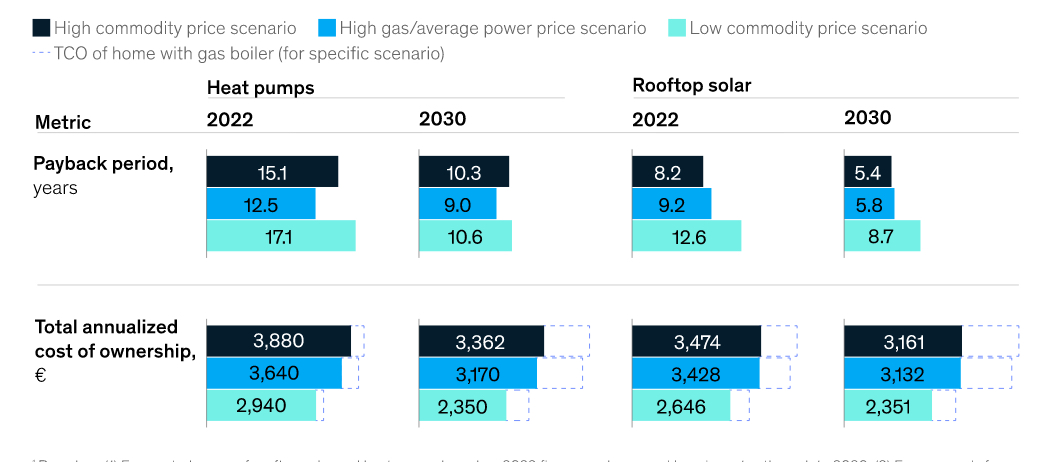From pv magazine Global
By 2030, the payback period for heat pumps and rooftop solar could fall by periods of several years, according to a new report by McKinsey & Company.
“Attractiveness of each investment (as measured by the payback period) is likely to increase as EU industries scale and reduce production and installation costs,” said the global management consulting firm .
The analysis considers three price scenarios, using a German single-family home as an example. A “high commodity price” scenario, a “high gas but average power price” scenario, and a low-commodity price scenario, where gas prices return to historical averages and power prices reach new lows.
Heat pumps and rooftop solar both have the longest payback periods in the low power price scenario, but it also has the high decreases in payback periods between 2022 and 2030. The payback periods for heat pumps could fall by 38%, from 17.1 years in 2022 to 10.6 years in 2030. The payback period for rooftop solar could fall by 31%, from 12.6 years in 2022 to 8.7 years in 2030.
Heat pumps have the shortest payback periods under the “average power price” scenario. The payback period could decrease by 28% in this time frame, from 12.5 years in 2022 to nine years in 2030. For rooftop solar, average payback periods could fall from 9.2 years in 2022 to 5.8 years in 2030.
Rooftop solar has the shortest payback periods under the “high-power price” scenario. It could fall 34% from 8.2 years in 2022 to 5.4 years in 2030. The payback period for heat pumps could go from 15.1 years in 2022 to 10.3 years in 2030, down 32%.
“These payback periods (and therefore household energy costs) could lower further due to decreasing electricity costs as the power system decarbonises and decentralises (reducing costs at peak times),” said McKinsey & Company.
The new study focuses on three initiatives that reportedly have the largest potential to substantially improve the energy efficiency of EU buildings: the ramping up of rooftop solar and heat pump installations, and the improvement of the insulation of buildings.
It finds that the yearly deployment of rooftop solar will need to be around 33 GW to reach the EU’s Fit-for-55 and Repower EU targets, compared with the record rate of 22 GW in 2022 and the 10 GW average of the last four years.
“Heat pump deployment will also need to keep growing at 12.5% a year through to 2030 to reach RePowerEU’s target of 54 million heat pumps by 2030,” the authors say. At the end of 2021, Europe had reportedly installed 15 million heat pumps, with McKinsey estimating an additional 2.5 million installations in 2022.
The consultancy firm suggests five key drivers to help catalyse these changes: upskilling the workforce, setting up appropriate incentive mechanisms, attracting financing and private capital, investing in grid infrastructure, and creating net-zero and circular supply chains.
The forthcoming March edition of pv magazine features an extended article from the McKinsey report authors about the outlook and competitiveness of the European solar production industry.
This content is protected by copyright and may not be reused. If you want to cooperate with us and would like to reuse some of our content, please contact: editors@pv-magazine.com.








If we could see the equivalent information, for Australia, it would be good.
Also, in the article,. with the “annualized cost” amounts, as I did not see the information in the article, are the amounts in terms of the euro value at each time, or, are they in terms of euro value equivalents, for a single time; in other words, are the amounts in terms of euro values as at 2022 and 2030, respectively, or, are they in terms of the euro value as at 2022?
Thanks for your comment Bret! Unfortunately, this modelling from McKinsey is focussed on Europe only – that modelling would need to be redone for Australia. The Australian Alliance for Energy Productivity last year published a report on heat pumps potential in Australia, which you can find here https://www.futureheat.info/_files/ugd/c1ceb4_c246ae788c664de3b8c77ff0bd4e2450.pdf. Its CEO Jarrod Leak spoke to pv magazine Australia about heat pumps applications in Australia and its cost curve, which you can find here https://www.pv-magazine-australia.com/2022/07/12/heat-pumps-grossly-underestimated-technology-for-australias-decarbonisation/. In terms of the euro values, they are the payback calculation at a single point in 2022 and 2030 respectively. Hope that’s helpful!